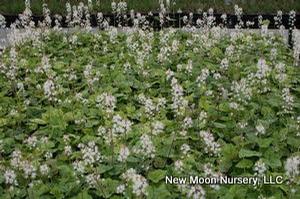New Moon Nurseries

Creeping foam flower is a perennial for shaded and woodland areas, makes a nice groundcover. Will naturalize.
Tiarella cordifolia
Creeping foam flower
Native to North America
FIRST IMPRESSIONS: Tiarella cordifolia is a low mounding wildflower that forms foot tall clumps. Plants have heart shaped lobed leaves that may have reddish or purplish veins. In spring, foliage is crowned by spikey racemes of starry pinkish white florets. Foamflower is a fine groundcover for woodlands or shade gardens with moist well drained soil.
HABITAT & HARDINESS: This species occurs in eastern North America in Quebec and Ontario, south to Nova Scotia, Maine and Georgia and west to Minnesota, Ohio Kentucky and Tennessee.
Tiarella cordifolia is indigenous to rich deciduous woodlands, hemlock or white cedar forests, open moist to slightly dry woods, seasonal floodplains, seeps, stream banks and open areas near woodland paths. Colonies of foamflower often follow courses of streams or creeks.
Plants are hardy from USDA Zones 4-9.
PLANT DESCRIPTION: Tiarella cordifolia is a clump forming perennial that spreads from stolons or runners.
The leaves are glossy and semi-evergreen with long petioles that originate directly from the runners. They are 4” across with 3-5 toothed maple-like lobes.
Foliage is often evergreen with red or purple veins and scattered glandular hairs. Blades can take on a reddish or bronze tint in autumn and winter.
In spring airy flower racemes rise from the foliage to a height of 10-12”. The racemes contain small white starry florets that emerge from pinkish buds. Each floret has long stamens that impart a foamy or feathery appearance.
The fruit is a small lopsided capsule that splits into two segments full of shiny black seed.
Plants grow 1’ tall with an equal spread. They form dense clumps and small colonies from spreading leafy stems that root at the nodes.
CULTURAL & MAINTENANCE NEEDS: Tiarella cordifolia flourishes in shady sites with average or moist well drained soil. Plants tolerate clay, loam, acid or alkaline pH, heat and some drought.
Plants are fairly pest resistant but need good air circulation to prevent issues with powdery mildew, slugs and rust. Foliage is occasionally nibbled by deer.
This species grows best in soils that are rich and moisture retentive but cannot tolerate sites that are wet or soggy in winter.
LANDSCAPE USES: This is a good Groundcover for a Wildlife Garden or Shade Garden. Plants are also used as Butterfly Nectar Plants or as part of a Grouping or Mass Planting. In mild climates attractive rosettes provide Winter Interest. Tiarella cordifolia has Showy Blooms and is appropriate for Cottage Gardens, Rock Gardens, Low Maintenance Plantings and Perennial Borders.
COMPANION & UNDERSTUDY PLANTS: Try pairing Tiarella cordifolia with Adiantum pedatum, Aquilegia canadensis, Athyrium filix-femina, Carex albicans, Carex plantaginea, Heuchera americana 'Dales Strain', Phlox stolonifera or Polystichum acrostichoides.
Tiarella wherryi has similar appearance and culture and could be substituted in some situations.
TRIVIA: It is reported that early season bees, pollinating flies, moths and butterflies visit the flowers.
This precocious wildflower begins producing viable seed barely a week after the flowers toward the tip of the racemes have withered.
The generic name is from the Greek tiara which refers to the shape of the seed capsule that resembles a turban once worn by Persian noblemen.
Tiarella cordifolia was the Georgia Native Plant Society’s 2003 Plant of the Year.
Height:
6-12 InchesSpread:
1-2 ftSpacing:
24-36 inUSDA Hardiness Zone:
4-9Bloom Color:
WhiteTiarella cordifolia Characteristics
Attracts Wildlife
- Pollinators
- Butterflies
Attributes
- Naturalizing
- Ground Cover
- East-Coast Native
Exposure
- Full Shade to Partial Shade
Flowering Months
- April
- May
Foliage Color
- Green
Growth Rate
- Medium
Season of Interest (Foliage)
- Summer
- Spring
- Winter
- Fall
Soil Moisture Preference
- Moist
Interesting Notes:
For more information on this plant, visit the USDA PLANTS Database: http://plants.usda.gov/java/profile?symbol=TICO